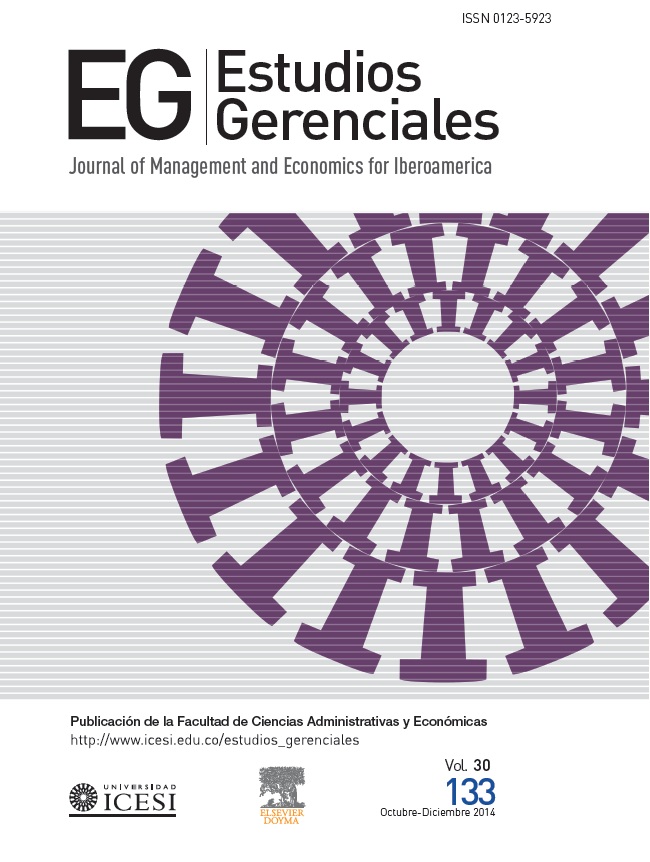Momentos estocásticos de orden superior y la estimación de la volatilidad implícita: aplicación de la expansión de Edgeworth en el modelo Black-Scholes
DOI:
https://doi.org/10.1016/j.estger.2014.01.021Keywords:
Volatilidad implícita, Expansión de Edgeworth, Asimetría, CurtosisAbstract
El documento utiliza la expansión de Edgeworth en el modelo de Black-Scholes para estimar la volatilidad implícita y el impacto en el precio de la opción de los momentos estocásticos de orden superior, sobre contratos de opciones del Grupo Financiero Galicia (GGAL), negociados en la Bolsa de Comercio de Bue- nos Aires (Argentina). Primero se analiza la distribución de probabilidad de rendimientos de subyacente; luego, el modelo se somete a iteración para obtener los valores implícitos de la volatilidad, asimetría y cur- tosis. Como principal conclusión se encuentran la forma aplanada de la curva de volatilidad implícita del modelo y el significativo peso de la asimetría y curtosis en el precio de las opciones «muy fuera/dentro del dinero».
Downloads
References
Alonso, J. y Arcos, M. (2006). Cuatro hechos estilizados de las series de rendimientos: una ilustración para Colombia. Estudios Gerenciales, 22(100), 103–124.
Baliero Filho, R. y Rosenfeld, R. (2004). Testing option pricing with Edgeworth expansion. Physica A: Statistical Mechanis an its Application, 344, 484–490.
Black, F. y Scholes, M. (1972). The valuation of pptions contracts and a test of market efficiency. Journal of Finance, 399–418.
Black, F. y Scholes, M. (1973). The pricing of options and corporate liabilities. Journal of Political Economy, 637–659.
Collan, M., Fullér, R. y Mezei, J. (2009). Fuzzy pay-off method for real option valuation. Journal of Applied Mathematics and Decision Systems, 1–14. ID 238196
Cramer, H. (1946). Mathematical methods for statistics. Princeton: Princeton University Press.
Datar, V. y Mathews, S. (2004). European Real Options: An intuitive Algorithm for the Black-Scholes Formula. Journal of Applied Finance, 14, 7–13.
Gaarder, E. (2007). Derivatives: Models on models (1.a ed). Chichester: John Wiley & Sons.
Jarrow, R. y Rudd, A. (1982). Aproximate option valuation for arbitrary stochastic processes. Journal of Financial Economics, 10, 347–369.
Kendall, M. y Stuarts, A. (1977). The advanced theory of statistics: Vol. 1 Distribution theory. New York: Mcmillan.
León, A., Mencia, J. y Sentaria, E. (2007). Parametric properties of seminonparametric distributions, with application to options valuation. Documento de Trabajo 0707 Banco de Espa˜na, 9-30.
Mathews, S., Datar, V. y Johnson, B. (2007). A practical method for valuing real options: The boeing approach. Journal of Applied Corporate Finance, 19, 95–104.
Merton, R. (1973). The theory of rational options princing. Bell Journal of Economics and Management Science, 141–183.
Milanesi, G., Tohmé, F. y Villlarreal, F. (2010). Series de tiempo y hechos estilizados en rendimientos de activos financieros. Actas XXX Jornadas de la Sociedad Argentina de Docentes en Administración Financiera (SADAF); (30): 206-232 [consultado 5 Mar 2011]. Disponible en: http://www.sadaf.com.ar/espanol/publicaciones/publicaciones individual.php?id=148
Rubinstein, M. (1994). Implied binomial trees. Journal of Finance, 49, 771–818.
Schleher, D. (1977). Generalized Gram-Charlier series with application to the sum of log-normal. IEEE Transactions on Information Theory, 23, 275–280.
Taleb, N. (2004). Fooled by randomness: The hidden role of chance in life and markets. New York: Random House.
Wilmott, P. (2009). Frequently asked questions in quantitative finance (2.a ed). United Kingdom: John Wiley & Sons.
Zdnek, Z. (2010). Generalised soft binomial American real option pricing model. European Journal of Operational Research, (207), 1096–1103.
Downloads
Published
Issue
Section
License
Articles are the sole responsibility of their authors, and will not compromise Icesi’s University principles or policies nor those of the Editorial Board of the journal Estudios Gerenciales. Authors authorize and accept the transfer of all rights to the journal, both for its print and electronic publication. After an article is published, it may be reproduced without previous permission of the author or the journal but the author(s), year, title, volume, number and range of pages of the publication must be mentioned. In addition, Estudios Gerenciales must be mentioned as the source (please, refrain from using Revista Estudios Gerenciales).








